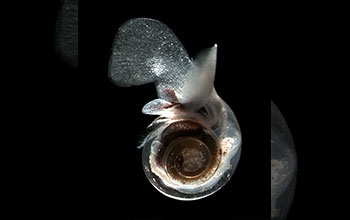Multimedia Gallery
Pteropod Limacina helicina
The pteropod Limacina helicina, the most common pelagic snail found in polar and sub-polar waters. The word Pteropod means winged-foot, and refers to the modification of the snail's foot into 2 wings--or paddles, that it uses to row through the water. These free-swimming planktonic mollusks form a calcium carbonate shell made of aragonite. They are an important food source for juvenile North Pacific salmon and also are eaten by mackerel, herring and cod.
More about this Image
Data gleaned from samples collected in the Pacific Ocean during a long-term study confirms that the oceans are becoming more acidic. The study focused on the effects of ocean acidification on water chemistry and marine organisms.
The data was collected over a 20 year period during a series of research cruises that spanned from the Southern to the Northern Hemispheres. The study was jointly funded by NOAA's Office of Global Programs (now the Climate Program Office) and the National Science Foundation's Divisions of Ocean Sciences as part of the Climate Variability and Predictability Study CO2 Repeat Hydrography Program. The final cruise ended in late March 2006 in Kodiak, Alaska.
The preliminary results from NOAA scientists and their academic colleagues indicate measurable pH decreases of approximately 0.025 units and increases in dissolved inorganic carbon of about 15 µmol/kg in surface waters over a large section of the northeastern Pacific. A lowering of pH indicates rising acidity. The decrease in pH is direct evidence of ocean acidification in the Pacific Ocean and can be attributed, for the most part, to anthropogenic carbon dioxide (CO2) uptake by the ocean over the past 15 years. This verifies earlier model projections that the oceans are becoming more acidic because of the uptake of CO2 released as a result of fossil fuel burning.
Researchers measured the rates of dissolution of the calcium exoskeletons of pteropods, free-swimming planktonic mollusks, subjected to the CO2-enriched waters. Based on the best available science, it appears that as levels of dissolved CO2 in seawater rise, the skeletal growth rates of calcium-secreting organisms will be reduced as a result of the effects of dissolved CO2 on ocean acidity and consequently, on calcification.
"The effects of decreased calcification in microscopic algae and animals could impact marine food webs and, combined with other climatic changes in salinity, temperature and upwelled nutrients, could substantially alter the biodiversity and productivity of the ocean," said Victoria Fabry of California State University-San Marcos, who worked on the study. "As humans continue along the path of unintended CO2 sequestration in the surface oceans, the impacts on marine ecosystems will be direct and profound," he adds. (Date of Image: August 2002)
Credit: Russ Hopcroft, University of Alaska, Fairbanks
Special Restrictions: For personal, educational and nonprofit and non-commercial use only. For commercial use, contact Russ Hopcroft of the University of Alaska, Fairbanks, at hopcroft@ims.uaf.edu to obtain permission.
Images and other media in the National Science Foundation Multimedia Gallery are available for use in print and electronic material by NSF employees, members of the media, university staff, teachers and the general public. All media in the gallery are intended for personal, educational and nonprofit/non-commercial use only.
Images credited to the National Science Foundation, a federal agency, are in the public domain. The images were created by employees of the United States Government as part of their official duties or prepared by contractors as "works for hire" for NSF. You may freely use NSF-credited images and, at your discretion, credit NSF with a "Courtesy: National Science Foundation" notation.
Additional information about general usage can be found in Conditions.
Also Available:
Download the high-resolution JPG version of the image. (588 KB)
Use your mouse to right-click (Mac users may need to Ctrl-click) the link above and choose the option that will save the file or target to your computer.



